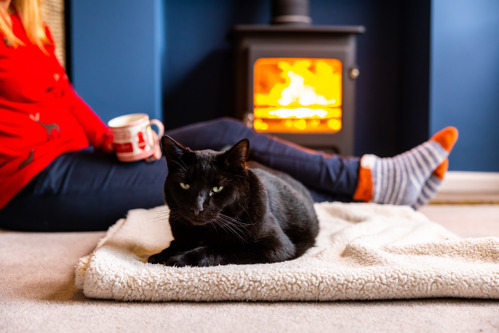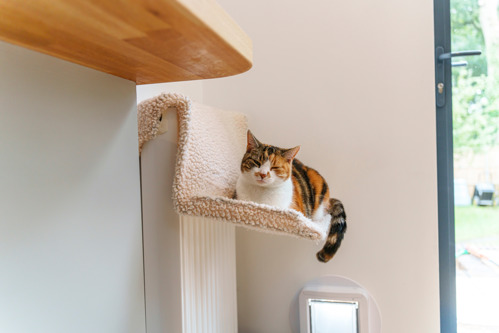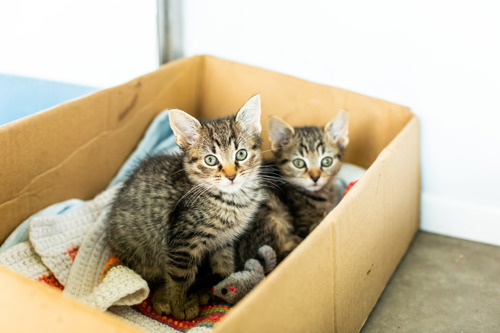What temperature is too cold for cats to survive? Find out how to spot the signs of hypothermia and frostbite in your cat
Despite their thick, furry coats, cats can feel the cold like humans and other animals.
Cats are warm blooded creatures. They have a normal body temperature of 38 to 39 degrees Celsius (100 to 102 degrees Fahrenheit), only slightly higher than ours. They need to keep their body temperature at this level to stay healthy. They are also descended from the desert-dwelling African wildcat. This means they much prefer warm temperatures to cold. But some breeds, such as Siberian cats, have adapted to live in colder climates.

During the winter months, cats are often very good at finding the cosiest places to keep warm. Their fur also provides great insulation to keep the cold out. This means that even when it feels chilly to us, cats will usually be feeling warm. But if temperatures drop too low, they can suffer from hypothermia and frostbite.
How cold is too cold for cats?
If it is cold outside, make sure your cat has free access to the house so they can come inside when they want to. They are usually very good at knowing when it’s too cold for them and when it’s time to seek warmth indoors. If there is extreme weather, such as blizzards or storms, it is best to bring them indoors. Keep them in until the bad weather has passed. Also be aware that some cats will feel the cold even more. It's best to keep them indoors if the weather is cold. This includes:
- elderly cats
- sick cats
- kittens
- certain breeds of cat with little or no fur
Find more advice on keeping your cat safe in cold weather.
How do I know if my cat is cold?

If your cat is feeling chilly, they will most likely seek out somewhere cosy. They will curl up into a ball to keep themselves warm. If they are otherwise behaving normally then there is no need to worry. You could try some of our tips below for cost-effective ways to help keep them cosy.
But if your cat is unable to find somewhere warm, their core body temperature could become dangerously low. This could result in hypothermia. They could also suffer from skin damage caused by frostbite.
Signs of hypothermia in cats
- Shivering. Cats shiver when it’s cold to help keep themselves warm. But if they become severely cold they may stop shivering
- Cold ears, paws and nose
- Pale gums
- Weak and lethargic movements
- Slow heart rate
- Slow breathing
- Confusion and clumsiness
- Collapse/loss of consciousness
These can also be signs of other serious health conditions. If you notice any of these symptoms in your cat, contact your vet straight away.
Signs of frostbite in cats
- The affected area may appear pale, grey or have a bluish tint
- The cat feels pain when the affected area is touched
- Blisters or skin ulcers
- Blackened or dead skin
If you notice any of these signs, speak to your vet straight away. Hypothermia and frostbite are extremely dangerous. They need to be treated quickly by a vet. You can also try some of these first aid tips while you arrange urgent veterinary care:
Hypothermia first aid
- If the cat is wet, dry them off with a towel. Wet fur will make them feel even colder
- Loosely wrap them in a blanket or towel
- Try giving them some lukewarm water to drink
- Gradually increase the temperature around them in the house or car while you are contacting the vet or travelling to the appointment. Don’t warm them up too quickly. Don't risk burning them with a hot water bottle or electric heat pad
Cost-effective ways to keep your cat warm in winter

There’s no need to spend lots of money on keeping your cat warm in winter. Unless the temperature indoors drops to seven degrees Celsius (45 degrees Fahrenheit) or lower, there is no need to put the heating on for your cat’s benefit. Even if you feel chilly, their fur will be helping to keep them warm. Here are some tips for keeping your cat warm on a budget.
- Make them cosy beds. You don’t need to buy expensive cat beds to keep your cat warm. Cardboard boxes lined with blankets or old jumpers will work perfectly. Place them in quiet, warm and dry areas of the house, away from any draughts. Make sure your cat can access them whenever they want to.
- Keep them indoors at night. It is best to keep your cat indoors at night all year round. Especially in winter when the temperature at night can drop particularly low. Make sure any exits are closed off to prevent escape. Make sure that they have a litter tray to use indoors whenever they need to.
- Dry them off. If your cat has been outside in the rain or snow and is comfortable being handled, gently dry them off with a towel when they come back indoors. They will feel colder if their fur is damp. If your cat appears stressed by being dried off, leave them alone. Most cats will groom to dry themselves off anyway, providing they have somewhere warm to go.
Find more money-saving tips for cat owners.
Stray and feral cats in the cold

When the weather turns cold, stray and feral cats are usually very good at finding somewhere to keep warm. Outbuildings, sheds or garages are popular options. When closing up any outbuildings, always have a quick check for cats so you don’t lock them in. Cats may also sometimes sneak into car bonnets to warm themselves from the heat of the engine. Have a quick check before you start up your car to make sure no cats are hiding inside.
Find out what to do if you find a cat and how to make them an outdoor cat shelter to keep them warm.



